System downtime is silently costing you.
Those surprise outages and performance lags aren’t just minor hiccups. They disrupt your entire business operation and erode user trust.
But managing a complex hybrid environment without unified oversight feels like you’re flying blind. This is a common and frustrating pain point.
According to Siemens, downtime can be incredibly expensive, with some industries seeing a $2.3 million per hour downtime cost. While your costs might differ, every minute of downtime hits your bottom line.
Proactive monitoring tools help you prevent these costly failures by providing full-stack visibility before small issues become critical problems.
If you’re also looking into robust IT security, my article on best vulnerability assessment tools covers essential solutions.
In this article, I’m going to guide you through the best IT infrastructure monitoring tools designed to boost your system uptime.
You will discover solutions that offer real-time data, rapid root-cause analysis, and help you achieve a more resilient IT environment.
Let’s get started.
Quick Summary:
| # | Software | Rating | Best For |
|---|---|---|---|
| 1 | Datadog → | Complex hybrid environments | |
| 2 | SolarWinds → | Hybrid IT teams | |
| 3 | ManageEngine → | Enterprise IT admins | |
| 4 | Paessler → | Small to large IT teams | |
| 5 | Nagios → | Complex IT environments |
1. Datadog

Struggling with complex IT monitoring challenges?
Datadog provides an integrated platform for monitoring and security, offering end-to-end visibility. This means you can simplify the oversight of your stack’s health and performance.
You’ll gain deep insights into your infrastructure, applications, and logs, helping you detect issues before they impact your uptime. This ensures you maintain a resilient and scalable IT environment.
Gain full-stack visibility effortlessly.
Datadog solves the problem of disparate monitoring tools by integrating observability, security, digital experience, and software delivery into one comprehensive solution. This allows you to monitor infrastructure, including containers, Kubernetes, and serverless environments, alongside application performance monitoring (APM) for deep dives into your applications.
The result is proactive, AI-driven monitoring of critical features, enabling you to optimize front-end performance and enhance user experiences. Additionally, its Security Monitoring capabilities help detect, prioritize, and respond to threats in real-time. Plus, with over 900 integrations, you can monitor any stack, any app, at any scale, anywhere.
This helps you achieve desired outcomes like rapid root-cause analysis.
Speaking of operational efficiency, my article on best janitor software covers how to optimize resource management.
Before diving deeper, you might find my analysis of offer management software helpful for scaling business operations.
Key features:
- Integrated Observability: Provides end-to-end, simplified visibility across your infrastructure, applications, and logs, crucial for understanding complex hybrid environments.
- Real-time Security Monitoring: Detects, prioritizes, and responds to threats in real-time, reducing security risks and improving overall system resilience.
- Comprehensive Integrations: Offers over 900 integrations for monitoring various cloud and on-premises technologies, ensuring full-stack visibility and seamless multi-platform integration.
Learn more about Datadog features, pricing, & alternatives →
Verdict: Datadog stands out with its integrated platform, offering end-to-end observability and real-time security across your entire stack. Its extensive integrations and AI-driven monitoring capabilities make it one of the best IT infrastructure monitoring tools for gaining full visibility and boosting system uptime in complex environments.
2. SolarWinds
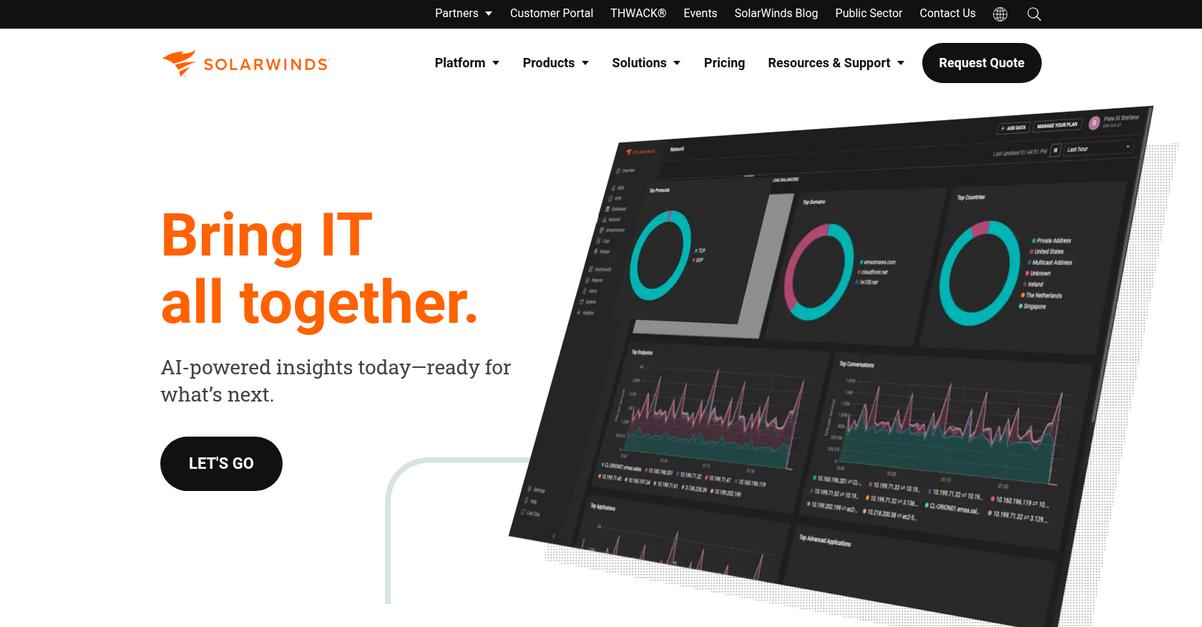
Is your IT infrastructure a tangled web of complexity?
You need clear insights to prevent outages, and SolarWinds provides that through comprehensive visibility. This means you can finally gain control over your entire IT stack, from applications to hardware. You can reduce troubleshooting time significantly.
It’s time for real-time performance data.
SolarWinds helps you unify your monitoring efforts across diverse environments. This enables you to quickly identify and resolve issues, ensuring your systems are always available. You’ll gain end-to-end visibility into your infrastructure, giving you a complete picture of performance. Plus, you can optimize resource allocation and plan for future capacity with confidence, preventing potential bottlenecks before they impact your business operations.
Boost your system uptime with ease.
While managing your IT infrastructure, considering efficient communication tools is also important. My guide on best virtual PBX systems can help.
Key features:
- Unified monitoring: Gain a single pane of glass view across your entire IT infrastructure, including on-premises, hybrid, and cloud environments.
- Performance optimization: Proactively identify and resolve performance issues to maintain peak system efficiency and reduce costly downtime.
- Capacity planning: Understand resource utilization and forecast future needs, ensuring your infrastructure scales effectively with your business growth.
Learn more about SolarWinds features, pricing, & alternatives →
Verdict: SolarWinds stands out for its ability to unify complex IT monitoring across hybrid environments, directly addressing the pain points of fragmented visibility. Its focus on proactive issue detection and root-cause analysis makes it an excellent choice for teams seeking the best IT infrastructure monitoring tools to boost system uptime and improve operational efficiency.
3. ManageEngine
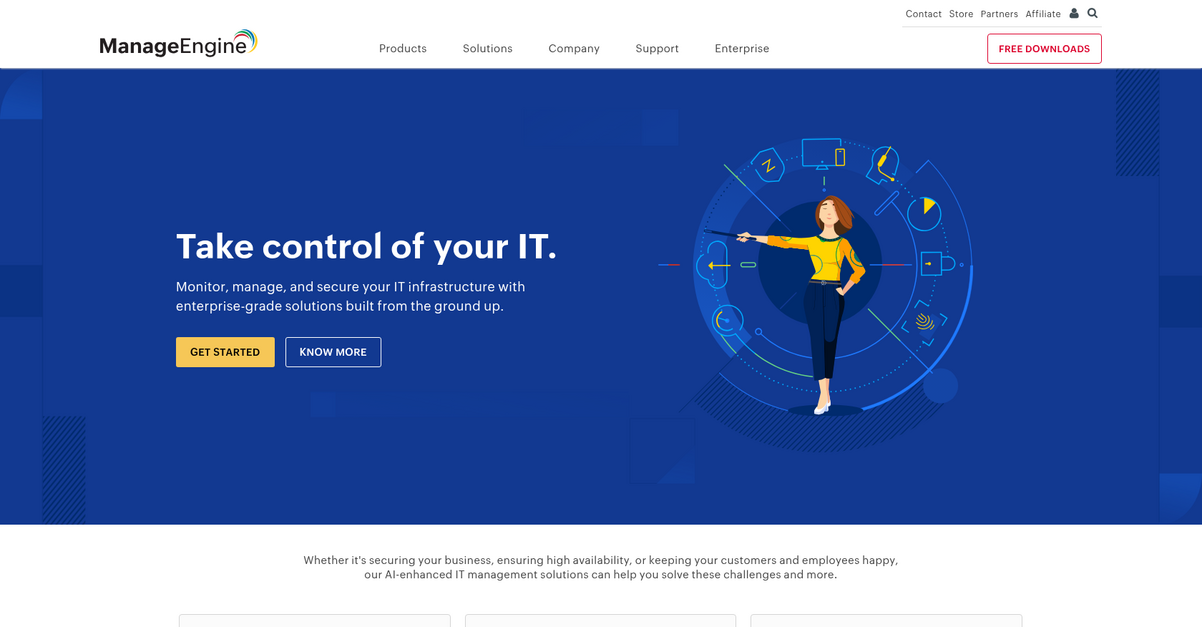
Struggling with IT chaos and frequent system downtime?
ManageEngine offers enterprise-grade solutions to monitor, manage, and secure your IT infrastructure. Their AI-enhanced IT management can help you ensure high availability.
This means you can address challenges like unified oversight and real-time data, ultimately achieving a resilient, scalable IT environment.
Here’s how they deliver.
ManageEngine helps you solve complex IT problems, offering solutions for identity and access management and unified endpoint management. This ensures your desktops, servers, and mobile devices are managed and secure.
They provide IT operations management and observability, allowing you to monitor and manage your network, servers, and applications, which is crucial for proactive problem detection. Additionally, their advanced IT analytics offer AI-powered insights, IT data correlation, and capacity planning, helping you visualize IT data and gain actionable insights.
This comprehensive approach helps you reduce troubleshooting time, improve security, and streamline operations, leading to better business continuity and productivity across your organization. You’ll gain full-stack visibility.
Gain control, boost uptime.
Speaking of streamlining operations, my guide on best food service management software could also help businesses reduce waste and boost margins.
Key features:
- IT Operations Management & Observability: Monitor and manage your network, servers, and applications, enhancing proactive issue detection and system uptime.
- Advanced IT Analytics: Visualize IT data and gain actionable, AI-powered insights, supporting smarter capacity planning and efficient IT operations.
- Unified Endpoint Management & Security: Securely manage desktops, laptops, servers, mobile devices, and browsers, reducing security risks and operational silos.
Learn more about ManageEngine features, pricing, & alternatives →
Verdict: ManageEngine offers comprehensive enterprise-grade solutions for IT infrastructure monitoring, providing crucial full-stack visibility, AI-powered insights, and robust security. These capabilities make it one of the best IT infrastructure monitoring tools for IT administrators seeking to boost system uptime and achieve a resilient IT environment.
4. Paessler
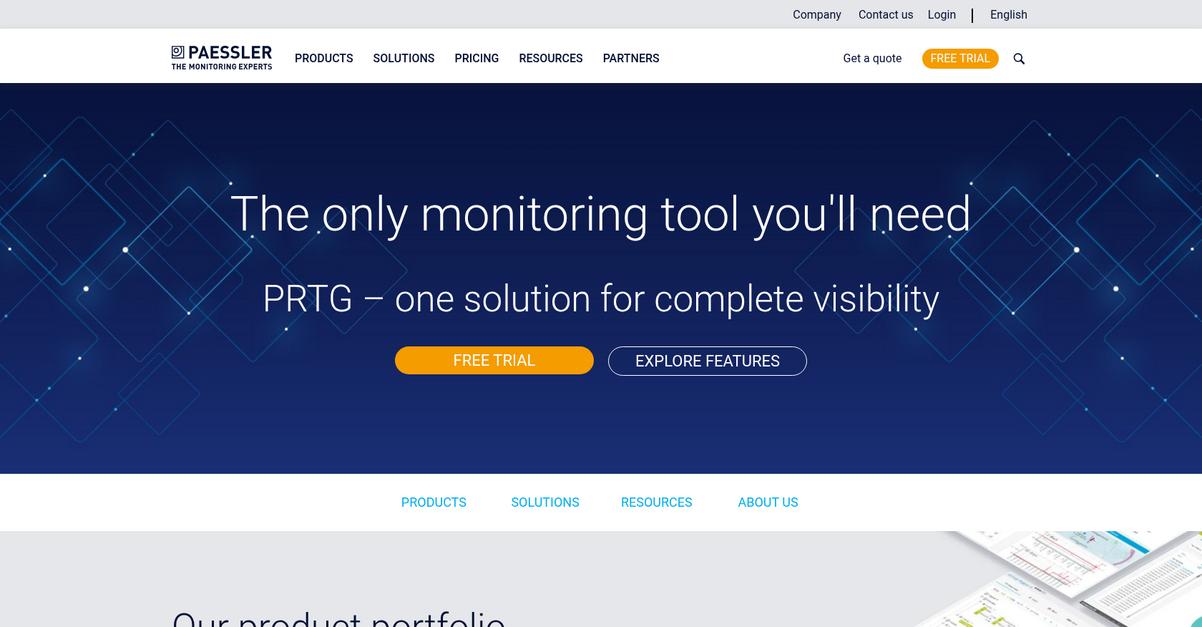
Is your IT infrastructure a tangled, unpredictable mess?
Paessler offers tools that provide complete visibility across your entire IT setup. This means you can monitor everything from networks to servers and bandwidth.
For your hybrid IT environment, Paessler’s solutions help keep your infrastructure optimized. This directly tackles the pain points of delayed issue detection.
This allows you to stop worrying.
Paessler simplifies monitoring by offering PRTG Network Monitor for small and midsize infrastructures, or PRTG Enterprise Monitor for large, multi-location environments. You can also opt for PRTG Hosted Monitor to manage everything from the cloud without dedicated hardware.
With these solutions, you can monitor all systems, devices, traffic, and applications. Plus, you get features like awesome maps and dashboards, flexible alerting, and customizable reporting. These capabilities ensure you avoid downtime by seeing what’s up and what’s not, analyzing bandwidth, and even monitoring your data centers, healthcare IT, and industrial IT systems.
It’s about gaining total control.
Before diving deeper, you might find my analysis of best account planning tools helpful in other areas of your business.
Key features:
- Complete infrastructure monitoring: Oversee networks, servers, bandwidth, and even specialized environments like data centers, healthcare, and industrial IT from one platform.
- Flexible alerting and reporting: Get immediate notifications on issues and generate in-depth, customizable reports to understand system performance and pinpoint bottlenecks.
- Multiple deployment options: Choose between PRTG Network Monitor for smaller needs, PRTG Enterprise Monitor for large-scale operations, or a hosted cloud solution for convenience.
Learn more about Paessler features, pricing, & alternatives →
Verdict: Paessler provides a comprehensive monitoring suite designed to offer complete visibility across complex and hybrid IT environments. With options for small, large, and cloud-hosted infrastructures, it simplifies real-time performance data collection, making it one of the best IT infrastructure monitoring tools for ensuring system uptime.
5. Nagios
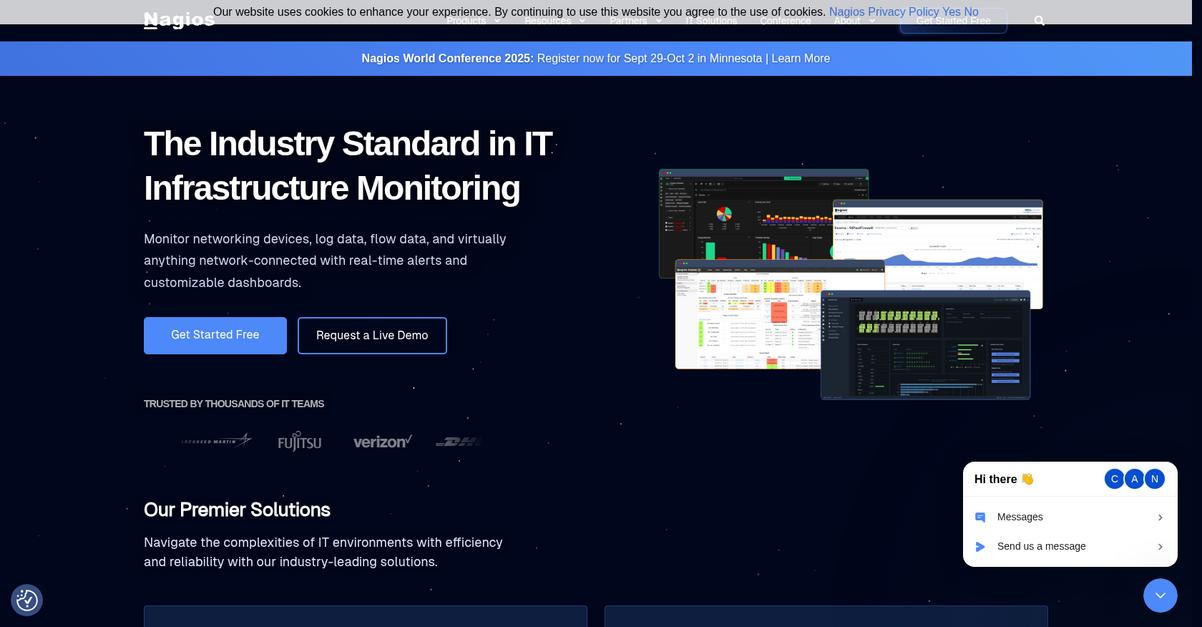
Struggling with IT infrastructure’s hidden complexities?
Nagios helps you monitor, troubleshoot, and proactively alert your infrastructure within a streamlined environment. This means you can keep tabs on networking devices, log data, and virtually anything network-connected.
You’ll gain comprehensive oversight, with real-time alerts and customizable dashboards, ensuring you resolve incidents before they become major catastrophes.
Here’s how Nagios can help.
Nagios provides robust solutions like Nagios XI for streamlined infrastructure monitoring and Nagios Log Server for insightful log data analysis. This gives you the power to search, query, and filter log data at scale.
Additionally, Nagios Network Analyzer offers NetFlow analysis and bandwidth utilization insights for your entire IT infrastructure. This allows you to gain in-depth insights into network traffic and overall health.
Plus, with Nagios Fusion, you can centralize management and visualize multiple Nagios instances and solutions on one screen, providing a high-level overview of distributed environments regardless of geographical location. The result is a system that can be nearly self-healing, as one user put it.
While this article focuses on enterprise IT, if you’re also exploring personal technology, you might find my guide on the best smart home system insightful.
Key features:
- Powerful Monitoring Engine: Leverage Nagios Core 4 for efficient, scalable monitoring and automated, integrated trending to plan for future upgrades.
- Comprehensive Dashboards & Alerting: Query, filter, and analyze incoming log events with a powerful dashboard system, creating alerts for specific thresholds.
- Centralized Management & Control: Gain complete system control over your distributed environments, managing polling frequency and user access securely from one location.
Learn more about Nagios features, pricing, & alternatives →
Verdict: Nagios provides robust monitoring solutions for complex IT environments, offering features like real-time alerts, customizable dashboards, and centralized management. Its ability to monitor virtually anything network-connected makes it one of the best IT infrastructure monitoring tools for ensuring system uptime and proactive issue resolution, as evidenced by satisfied users.
6. Zabbix
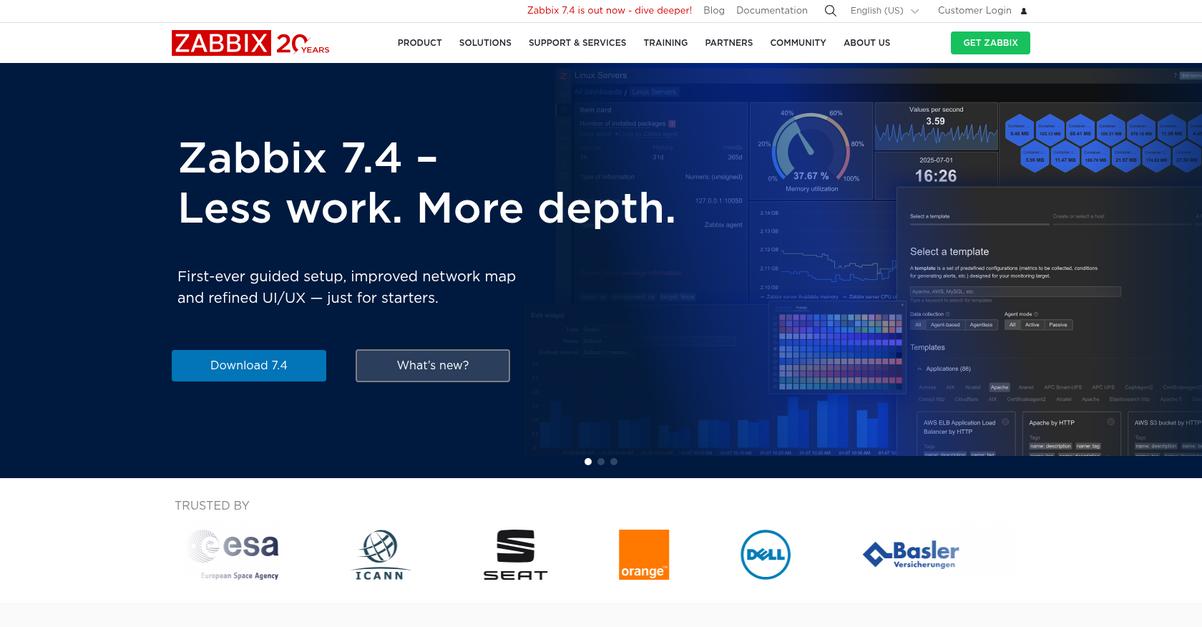
Struggling with complex, sprawling IT infrastructure?
Zabbix offers a universal, open-source observability solution, giving you a unified view. This means you can effectively monitor everything from your networks, servers, and cloud environments to containers, IoT, and applications.
The latest Zabbix 7.4 release provides guided setup, improved network maps, and refined UI/UX, making management simpler. You gain complete visibility to address those frequent downtime and troubleshooting challenges.
Here’s your path to resilient IT.
Zabbix helps you maintain efficient operations and achieve zero downtime for business-critical systems. This means you can deploy Zabbix on-premise for full ownership and data privacy, or opt for Zabbix Cloud for scalability and built-in security with zero maintenance.
You can also integrate Zabbix into your existing cloud environment, like AWS, Azure, or Google Cloud, leveraging cloud-native services. Additionally, Zabbix provides 24/7 technical support with an average 12-minute response time, ensuring rapid problem resolution and expert assistance whenever you need it.
Plus, case studies like SEB Bank show how Zabbix provides a reliable, customized log monitoring platform, while the European Space Agency relies on it for real-time tracking of the Columbus Lab.
The result is truly unified observability.
Key features:
- Universal Monitoring: Monitor any aspect of your IT and OT infrastructure, including cloud, networks, servers, containers, IoT, and various applications.
- Flexible Deployment: Choose between Zabbix On-Premise for full control and data privacy, or Zabbix Cloud for managed scalability and reduced maintenance.
- Comprehensive Visibility: Gain a single pane of glass view into your entire IT landscape, enabling proactive issue detection, capacity planning, and efficient troubleshooting.
Learn more about Zabbix features, pricing, & alternatives →
Verdict: Zabbix offers a powerful, open-source solution that empowers IT administrators and decision-makers to achieve full-stack visibility and proactive issue resolution across complex, hybrid environments. Its ability to monitor anything, coupled with flexible deployment options and strong enterprise adoption, makes it one of the best IT infrastructure monitoring tools.
7. New Relic
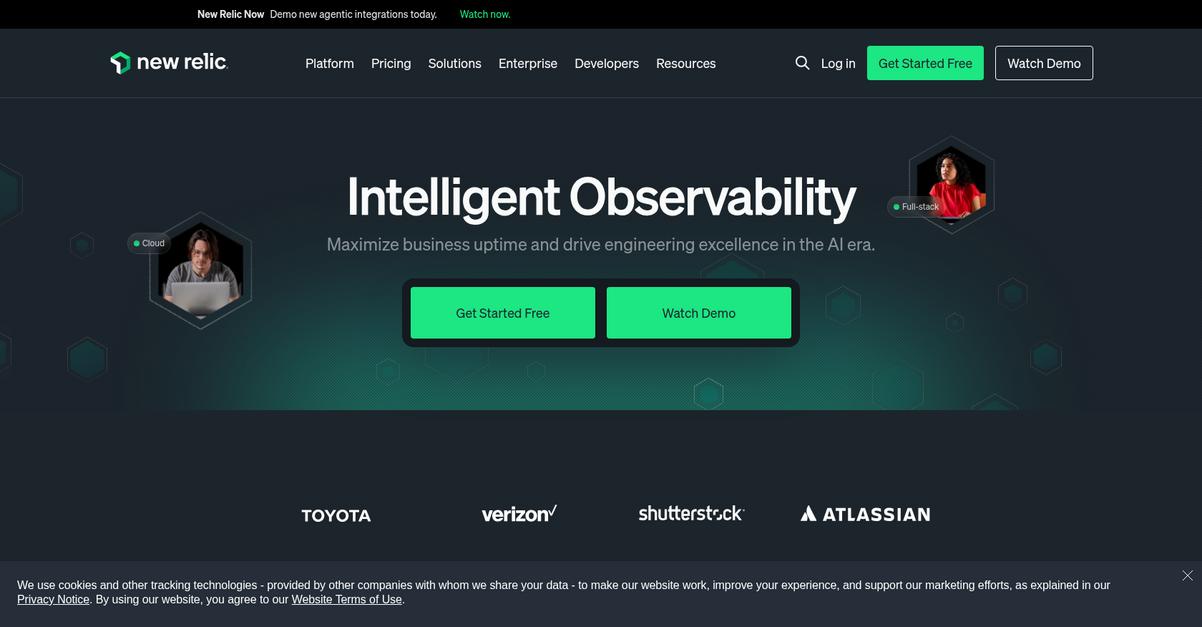
Struggling with complex IT environments and downtime?
New Relic provides intelligent observability, offering over 50 capabilities in one platform. This means you can resolve issues up to 5x faster.
You can finally see your entire full stack, from front-end to back-end, infrastructure, and logs, making troubleshooting much more efficient.
Here’s how New Relic helps.
It offers full-stack monitoring, including cloud, network, and Kubernetes, giving you complete visibility. You can focus on the data and stack that matter most.
New Relic also gives you up to 5x more value by letting you only pay for actual usage, not peak usage, avoiding overages. Additionally, features like Alerts, Anomalies, and Dashboards help you proactively identify and fix problems before they impact your users. This consolidates tools, tearing down operational silos and making your team more productive.
The result is maximized business uptime.
Beyond monitoring, optimizing digital adoption processes enhances overall productivity.
Key features:
- Full-Stack Observability: Monitor your entire IT environment, including applications, infrastructure, and security vulnerabilities, from a single platform.
- Intelligent Transaction Monitoring: Resolve issues up to 5x faster with deep insights into transactions across your stack, focusing on critical data.
- Cost-Effective Usage-Based Pricing: Pay only for what you actually use, ensuring you get maximum value without penalties or overages.
Learn more about New Relic features, pricing, & alternatives →
Verdict: New Relic stands out as one of the best IT infrastructure monitoring tools due to its comprehensive full-stack observability, including cloud and Kubernetes monitoring, which directly addresses complex hybrid environments. Its ability to resolve issues 5x faster, combined with value-driven pricing, provides the proactive insights needed for resilient, scalable IT.
8. LogicMonitor

Struggling with complex IT environments and frequent downtime?
LogicMonitor provides real-time insights for your infrastructure, offering seamless, agentless monitoring. This means you gain full visibility without cumbersome deployments.
The software helps you manage vast device networks and eliminate alert noise, enabling faster issue resolution and improved service availability.
You’ll quickly see how LogicMonitor pinpoints problems and guides your next steps.
LogicMonitor solves this by unifying your monitoring.
You get comprehensive observability across your infrastructure, including network, server, virtual machine, and cloud environments like AWS, GCP, and Azure. This allows you to consolidate monitoring tools by up to 83%, reducing operational silos.
Additionally, LogicMonitor’s AI-powered Edwin AI and Event Intelligence capabilities proactively identify and prevent issues, helping reduce MTTR by 46%. Plus, it boasts over 3000 integrations for instant compatibility, accelerating your digital transformation.
The result is a more resilient and scalable IT environment.
Speaking of digital transformation, ensuring robust API security testing is crucial for modern software development.
Key features:
- Unified Monitoring Platform: Provides comprehensive, real-time insights and automation for all your IT infrastructure, including on-prem, cloud, and hybrid environments.
- AI-Powered Observability: Leverages Edwin AI and Event Intelligence to reduce alert noise, accelerate root cause analysis, and proactively prevent issues before they impact your business.
- Extensive Integrations & Automation: Offers over 3000 pre-built integrations for rapid deployment and automated discovery across diverse technologies, streamlining your monitoring setup.
Learn more about LogicMonitor features, pricing, & alternatives →
Verdict: LogicMonitor is an ideal solution for IT teams navigating complex, hybrid environments, offering proactive, AI-powered observability that unifies data and reduces MTTR by 46%. This makes it one of the best IT infrastructure monitoring tools for boosting system uptime and operational efficiency.
9. Splunk

Is complex IT infrastructure causing you headaches?
You need full-stack observability to detect and resolve performance issues quickly, keeping your applications and business running smoothly.
This means you can streamline, prioritize, and automate IT operations workflows with agentic AI, optimizing the performance of your mission-critical services for smooth operations.
You can prevent major issues.
Splunk offers an extensible data platform powering unified security and full-stack observability. This allows you to gain complete visibility into even the most complex digital ecosystems.
You can detect, investigate, and respond at the speed of AI, troubleshooting workflows with agentic AI and natural language without needing deep expertise across all your operational data. Additionally, you can optimize cloud monitoring, improve end-user experiences, reduce alert noise, and debug problems in microservices. The result is quicker problem resolution.
This allows your team to fix problems faster while optimizing costs by unifying and streamlining workflows for ITOps and engineering teams. Plus, it helps you secure and observe your AI stack, providing the visibility and insights needed to stay compliant and reliable while boosting productivity.
Experience ultimate system uptime.
While optimizing your infrastructure, you might also be looking to unify your customer data. For that, my guide on best customer data platform can be helpful.
Key features:
- Unified Security and Observability: Gain complete visibility and streamline workflows for IT operations and engineering teams, accelerating detection, investigation, and response.
- AI-Powered Automation: Utilize agentic AI and AI Assistants to automate security and IT operations workflows, helping you prevent major issues and quickly find and fix vulnerabilities.
- Full-Stack and Cloud Monitoring: Optimize performance for your complex, hybrid IT environments, extending visibility to the cloud and improving end-user experiences.
Learn more about Splunk features, pricing, & alternatives →
Verdict: Splunk provides market-leading security and observability solutions for IT administrators, enabling them to gain comprehensive, full-stack visibility. It leverages AI-powered automation to prevent issues, resolve threats and downtime faster, and improve productivity, making it one of the best IT infrastructure monitoring tools.
Conclusion
Keeping your systems online is everything.
Choosing the right monitoring tool for a complex, hybrid environment is a major challenge. The wrong one leaves you with critical blind spots.
Downtime isn’t just an inconvenience; it’s a direct hit to your bottom line. Gartner reports a $5,600 average cost per minute for IT downtime. That’s a staggering financial risk that most businesses simply cannot afford to ignore.
So what is the best path forward?
From my extensive review, Datadog stands out as the top solution. It excels at providing the unified visibility needed to prevent downtime.
For further insights into optimizing business processes and data flow, my guide on best form automation software provides valuable perspectives.
Its integrated platform masterfully combines monitoring, security, and analytics into one dashboard. It’s one of the best IT infrastructure monitoring tools for proactive, real-time threat detection and root-cause analysis.
I strongly recommend you start a free trial of Datadog to experience its end-to-end observability and see the immediate impact.
You’ll finally achieve a resilient IT environment.






